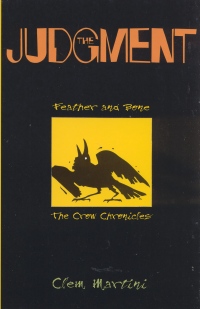| ________________
CM . . .
. Volume XIII Number 2 . . . .September 15, 2006 
 |
The Judgment. (Feather and Bone: The Crow Chronicles).
Clem Martini.
Toronto, ON: Kids Can Press, 2006.
299 pp., cloth, $16.95.
ISBN 1-55337-756-7.
Subject Heading:
Crows-Juvenile fiction.
Grades 5-9 / Ages 10-14.
Review by Michelle Superle.
** /4 |
| |
|

excerpt:
“. . . you did that for you. You didn’t do it for those sorry Crows who followed you initially. And much good it’s done several of them—they’re just scavenge for groundlings now. And you think that’s what it takes to be Chooser? To risk everything and everyone to get what you want? A little flying, a little quick thinking, a little risk taking. Hey? Is that what you think? You poor, clueless, innocent chick,” Kuru said, suddenly sounding genuinely sad. “We all want things, and are trying to get them every day, but that has nothing to do with Choosing. Not a thing. And you will be a Chooser, a genuine Chooser, when you do something for the flock that has nothing, and I mean nothing, to do with you, or what you want.”
Kuru glanced down ruefully at the berry he’d rejected. . . . And he dropped down to the creek bed.
Kyp remained sitting on the branch for some time on his own, lost in thought.
Clem Martini’s third “Crow Chronicle,” The Judgment, finally concludes this series of books about crow lore and the fate of one flock of crows. The Judgment, like the first two “Crow Chronicles,” is suitable for readers aged 10 to 14. The problem set up in the first story—the displacement of Kyp’s flock as a result of a devastating illness (The Plague)— is finally resolved, as the young crows form a cohesive social unit, choose a leader (Chooser), escape the malevolent intentions of an enemy flock, and find a new homeland.
This quest is the basis of The Judgment, and thus the story lends itself to Martini’s philosophical musings on freedom, group dynamics, leadership, and the consequences of actions—and how all of these elements interact. Not only are these musings sophisticated, with something enlightening to say about the process of building a life, but they are also intriguingly multicultural. Indeed, Martini highlights a leader’s need to be a visionary with the symbolic blinding of Kyp at the end of The Judgment, an action that surely draws a parallel with ritualistic blinding of shamans and wise elders in traditional cultures.
Martini certainly manages to strike a harmonious balance between storytelling, philosophizing, and imparting information about his imaginary crow society, and in this he has progressed since his first “Crow Chronicle” which seemed mostly a vehicle to explore crow anthropology. However, there is still something curiously absent in The Judgment—some readability that Martini managed to instill into The Mob, the second book of the trilogy. It’s difficult to say exactly why I didn’t feel passionately invested in the fates of the crows while I was reading The Judgment, but I simply didn’t care particularly about what happened to them. I contrast this sharply with my experience of reading Kenneth Oppel’s “Silverwing trilogy” during which I could hardly put the books down and was constantly rooting for the protagonists’ success. Perhaps it’s unfair to compare these two series, but they do seem to be Canadian cousins—both animal fantasy biographies.
In terms of style, The Judgment and the other two books in the “Crow Chronicles” could be more favourably compared with the “Lord of the Rings” trilogy. In both series, it seems that the authors’ primary aim is to make real their fantasy worlds and to explore the realities of those living there. In neither are readers usually given the chance to relate to one particular protagonist; rather, many important characters all play important roles, thus emphasizing the collectivity of the societies and the causes at the center of the stories while hampering reader identification and empathy. In The Judgment, however, this distance is exacerbated and problematized by the irritating, inexplicable shift in point of view from first person (which hardly seems necessary as the speaker acts more as a “camera” than a character) to a clumsily integrated omniscient point of view. Although this may have been meant to add to the story by opening up perspectives, it actually detracts from the story and could even be confusing for younger readers.
As I’ve said before, I believe that a certain type of reader—one who enjoys a richly-detailed, “fact” heavy fantasy world heavy on action and lean on empathy for or connection with characters—will enjoy the “Crow Chronicles” very much, and that same kind of reader will also likely enjoy The Judgment, the last book in the series.
Recommended.
Michelle Superle teaches Children’s Literature and Composition at the University College of the Fraser Valley.

To comment
on this title or this review, send mail to cm@umanitoba.ca.
Copyright © the Manitoba Library Association. Reproduction for personal
use is permitted only if this copyright notice is maintained. Any
other reproduction is prohibited without permission.
NEXT REVIEW |
TABLE OF CONTENTS FOR THIS ISSUE
- September 15, 2006.
AUTHORS |
TITLES |
MEDIA REVIEWS |
PROFILES |
BACK ISSUES |
SEARCH |
CMARCHIVE |
HOME |
